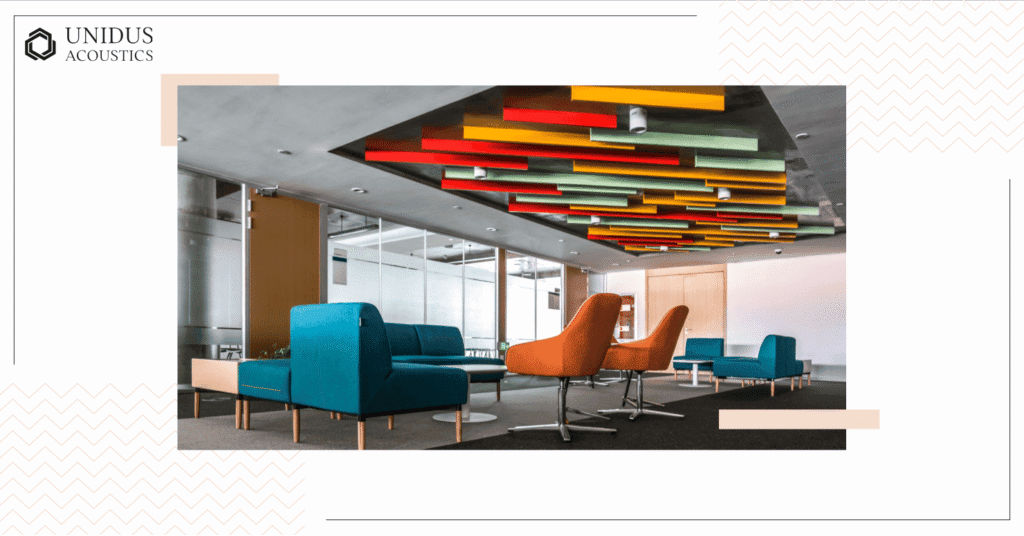“How can such a lovely space be so noisy?”
This question comes up constantly at Unidus Acoustics. Designers spend months, sometimes years, perfecting the visual elements, choosing those stunning materials that make spaces photograph like a dream, creating environments that look absolutely flawless in architectural magazines.
But then reality hits hard. The moment people actually start working in these spaces, the acoustic nightmare begins. Conversations turn into shouting matches, productivity tanks, and that carefully crafted ambience dissolves faster than sugar in monsoon rain.
What’s missing? Understanding Noise Reduction Coefficient (NRC) ratings and how they actually translate into real-world acoustic performance. And honestly, it’s not anyone’s fault that this gets overlooked; most architecture programs barely touch on acoustics, focusing instead on the visual and structural elements.
After four decades of designing custom acoustic solutions for commercial spaces across India, here’s what becomes crystal clear: NRC isn’t just some technical specification buried deep in product datasheets. It’s literally the bridge between beautiful design and functional acoustics.
What Noise Reduction Coefficient (NRC) Really Means in Your Projects
Noise Reduction Coefficient measures how much sound a material absorbs rather than bounces back into a space. Think of it as an efficiency rating for sound absorption, scaled from 0.00 (reflects everything back, like concrete or that gorgeous glass wall everyone loves) to 1.00 (absorbs virtually all sound that hits it).
Here’s what actually matters for specifications: represents the average absorption across four key frequencies: 250Hz, 500Hz, 1000Hz, and 2000Hz.
Essentially, that’s the range of human speech. When acoustic panel manufacturers claim their products have an NRC of 0.85, they’re saying those panels absorb 85% of the sound energy hitting them across these frequencies.
But here’s where so many specifications go completely sideways. NRC gets tested under laboratory conditions using ASTM C423 standards (a test method for measuring the sound absorption properties of materials using a reverberation room).
Real-world performance? That depends on installation quality, room geometry, and how materials actually work together in practice. A panel with NRC 0.90 won’t magically solve acoustic problems if it’s poorly installed or represents only 10% of the total wall surface.
Choosing the Right NRC for Different Spaces
The NRC needed depends entirely on what the space should achieve acoustically. After thousands of projects across every type of commercial environment, these ranges consistently deliver the best results:

Open offices benefit from NRC 0.70-0.85 on walls. This level reduces ambient noise without making the space feel dead or lifeless. Lower ratings leave too much echo (HR departments hate this), while higher ratings can actually make speech harder to understand across workstations. There’s definitely a sweet spot here.
Meeting rooms need NRC 0.80 or higher for speech privacy and clarity. Confidential conversations require aggressive sound absorption, especially when rooms share walls with other workspaces. The number of awkward situations prevented with proper meeting room acoustics is honestly staggering.
Reception areas work best with NRC 0.60-0.75. Some acoustic liveliness creates a welcoming atmosphere; nobody wants to walk into what feels like a library, but enough absorption keeps conversations comfortable for both staff and visitors.
Restaurants typically need NRC 0.65-0.80. The challenge here involves balancing the energetic buzz that diners expect (quiet restaurants feel weird and awkward) with enough absorption to prevent that dreaded “shouting over noise” spiral. You know exactly what this means: when the whole place gets progressively louder until everyone’s practically yelling just to be heard.
NRC: Real-World Material Performance
Let’s talk specific solutions that actually work in practice.
At Unidus Acoustics, the fabric-wrapped wall panels typically achieve NRC 0.75-0.95, depending on thickness and core material. These work brilliantly in corporate settings where aesthetics matter just as much as performance, sometimes more, honestly.
Polyester acoustic panels consistently deliver NRC 0.85-1.00 with excellent frequency response across the board. They’re particularly effective in spaces where speech clarity becomes critical: think conference rooms or educational facilities where every word needs to be crystal clear.

Wood wool panels offer NRC 0.60-0.80 while maintaining those natural aesthetics that biophilic design demands. Perfect for hospitality venues or modern office designs where acoustic performance can’t come at the expense of warmth and visual appeal.
Ceiling solutions vary more widely than most people realize. Mineral fibre tiles typically provide NRC 0.70-0.85, while custom ceiling baffles can achieve NRC 0.85-1.00 when properly spaced.
But here’s the thing: ceiling treatments alone rarely solve acoustic problems completely. Wall treatments become essential for comprehensive sound management, especially in open-plan environments.
Beyond the Numbers: What NRC Doesn’t Tell You
NRC remains crucial, but it’s definitely not the whole story.
- First, frequency response matters way more than the average. A material might average NRC 0.80 but perform terribly at low frequencies where HVAC noise dominates the soundscape. Always demand frequency-specific data, not just that single NRC number that marketing departments love to highlight.
- Second, installation dramatically affects real-world performance. Gaps around panels, poor mounting techniques, or incorrect spacing can reduce effective NRC (Noise Reduction Coefficient) by 20-30%. This explains why Unidus provides detailed installation supervision for critical projects—the difference between good and great results often comes down to execution quality.
- Third, room geometry influences everything about acoustic performance. High ceilings, parallel walls, and hard surfaces all interact with acoustic treatments in complex ways. A material with excellent NRC might still leave occupants dealing with flutter echoes or standing waves if the overall acoustic design isn’t properly considered from the start.
NRC: Red Flags to Avoid
Be extremely wary of NRC claims above 1.00: physically impossible in real applications, despite what some suppliers might suggest. Question any supplier who can’t provide comprehensive frequency response data or legitimate testing certifications.
Avoid the temptation to specify acoustic treatments as an afterthought during construction. Early acoustic planning prevents costly retrofits and ensures optimal performance from day one.
Don’t rely solely on ceiling treatments for acoustic solutions. Most acoustic problems require wall-mounted solutions for effective speech management and ambient noise reduction.
The Bottom Line
Noise Reduction Coefficient ratings guide material selection effectively, but successful acoustic design requires understanding how those materials work together in real spaces. The goal isn’t achieving the highest possible NRC—it’s delivering the right acoustic performance for each specific application.
At Unidus Acoustics, custom acoustic solutions balance performance with aesthetics seamlessly. Four decades of expertise mean understanding not just the technical specifications, but how to achieve acoustic goals while enhancing design vision rather than compromising it.
Ready to solve acoustic challenges?
Let’s discuss how proper NRC (Noise Reduction Coefficient) specification can transform acoustic performance without compromising visual impact.

